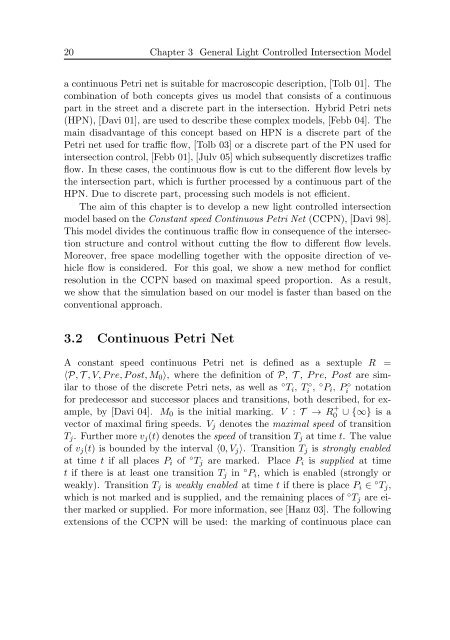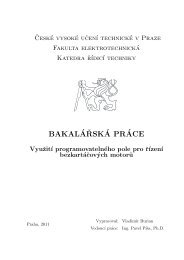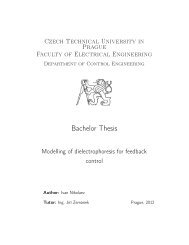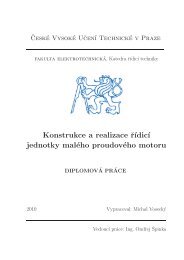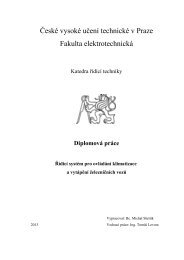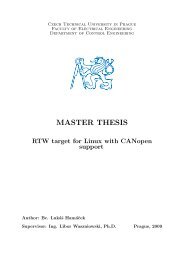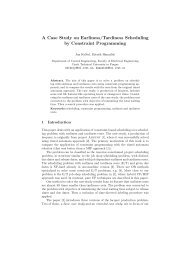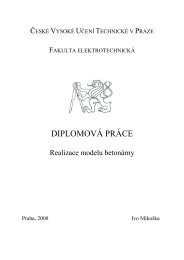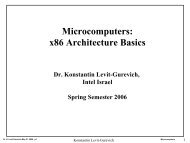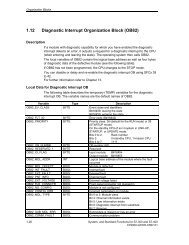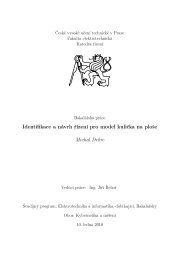Modeling and Optimization of Traffic Flow in Urban Areas - Czech ...
Modeling and Optimization of Traffic Flow in Urban Areas - Czech ...
Modeling and Optimization of Traffic Flow in Urban Areas - Czech ...
Create successful ePaper yourself
Turn your PDF publications into a flip-book with our unique Google optimized e-Paper software.
20 Chapter 3 General Light Controlled Intersection Modela cont<strong>in</strong>uous Petri net is suitable for macroscopic description, [Tolb 01]. Thecomb<strong>in</strong>ation <strong>of</strong> both concepts gives us model that consists <strong>of</strong> a cont<strong>in</strong>uouspart <strong>in</strong> the street <strong>and</strong> a discrete part <strong>in</strong> the <strong>in</strong>tersection. Hybrid Petri nets(HPN), [Davi 01], are used to describe these complex models, [Febb 04]. Thema<strong>in</strong> disadvantage <strong>of</strong> this concept based on HPN is a discrete part <strong>of</strong> thePetri net used for traffic flow, [Tolb 03] or a discrete part <strong>of</strong> the PN used for<strong>in</strong>tersection control, [Febb 01], [Julv 05] which subsequently discretizes trafficflow. In these cases, the cont<strong>in</strong>uous flow is cut to the different flow levels bythe <strong>in</strong>tersection part, which is further processed by a cont<strong>in</strong>uous part <strong>of</strong> theHPN. Due to discrete part, process<strong>in</strong>g such models is not efficient.The aim <strong>of</strong> this chapter is to develop a new light controlled <strong>in</strong>tersectionmodel based on the Constant speed Cont<strong>in</strong>uous Petri Net (CCPN), [Davi 98].This model divides the cont<strong>in</strong>uous traffic flow <strong>in</strong> consequence <strong>of</strong> the <strong>in</strong>tersectionstructure <strong>and</strong> control without cutt<strong>in</strong>g the flow to different flow levels.Moreover, free space modell<strong>in</strong>g together with the opposite direction <strong>of</strong> vehicleflow is considered. For this goal, we show a new method for conflictresolution <strong>in</strong> the CCPN based on maximal speed proportion. As a result,we show that the simulation based on our model is faster than based on theconventional approach.3.2 Cont<strong>in</strong>uous Petri NetA constant speed cont<strong>in</strong>uous Petri net is def<strong>in</strong>ed as a sextuple R =〈P, T , V, P re, P ost, M 0 〉, where the def<strong>in</strong>ition <strong>of</strong> P, T , P re, P ost are similarto those <strong>of</strong> the discrete Petri nets, as well as ◦ T i , Ti ◦,◦ P i , Pi◦ notationfor predecessor <strong>and</strong> successor places <strong>and</strong> transitions, both described, for example,by [Davi 04]. M 0 is the <strong>in</strong>itial mark<strong>in</strong>g. V : T → R 0+ ∪ {∞} is avector <strong>of</strong> maximal fir<strong>in</strong>g speeds. V j denotes the maximal speed <strong>of</strong> transitionT j . Further more v j (t) denotes the speed <strong>of</strong> transition T j at time t. The value<strong>of</strong> v j (t) is bounded by the <strong>in</strong>terval 〈0, V j 〉. Transition T j is strongly enabledat time t if all places P i <strong>of</strong> ◦ T j are marked. Place P i is supplied at timet if there is at least one transition T j <strong>in</strong> ◦ P i , which is enabled (strongly orweakly). Transition T j is weakly enabled at time t if there is place P i ∈ ◦ T j ,which is not marked <strong>and</strong> is supplied, <strong>and</strong> the rema<strong>in</strong><strong>in</strong>g places <strong>of</strong> ◦ T j are eithermarked or supplied. For more <strong>in</strong>formation, see [Hanz 03]. The follow<strong>in</strong>gextensions <strong>of</strong> the CCPN will be used: the mark<strong>in</strong>g <strong>of</strong> cont<strong>in</strong>uous place can


